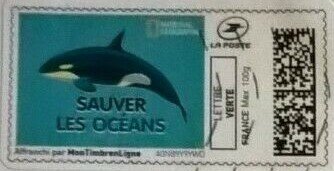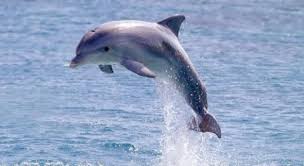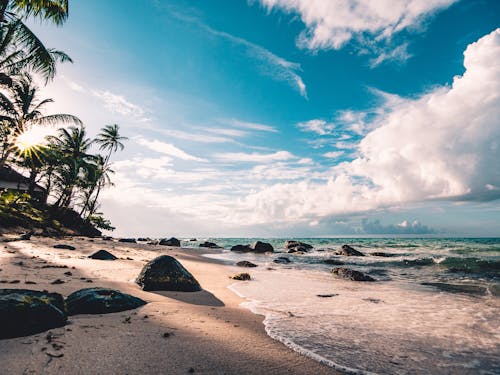Stamp: Save the Oceans. Sauver les Oceans (Personalized and Private Mail Stamps 2020)
Save the Oceans. Sauver les Oceans (Personalized and Private Mail Stamps 2020)
01 January (Personalized and Private Mail Stamps ) within release France : TimbrEnLigne. Ecology and Environment goes into circulation Stamp Save the Oceans. Sauver les Oceans face value 100 Gram
| Stamp Save the Oceans. Sauver les Oceans in catalogues | |
|---|---|
| Colnect codes: | Col: FR-TIM 2020-47 |
Stamp is square format.
Also in the issue France : TimbrEnLigne. Ecology and Environment:
- Stamp - Green Earth face value 20;
- Stamp - Save the Planet. Sauver La Planete face value 20;
- Stamp - Green Man on a Ladder Watering the Earth face value 20;
- Stamp - Take Care of of the Earth. Prenons Soin de la Terre face value 20;
- Stamp - Hands Holding a Sapling face value 20;
- Stamp - Two Green Leaves face value 50;
- Stamp - Durable in Green face value 20;
- Stamp - Save the Oceans. Sauver les Oceans face value 100;
- Stamp - Ecology in Green. Ecologie face value 50;
- Stamp - Ride Green. Rouler Vert face value 50;
- Stamp - Green Clouds face value 20;
- Stamp - Zero Waste. Zero Dechets face value 20;
- Stamp - Energy Durable. Energie Durable face value 20;
- Stamp - Green Eco Pictograms face value 20;
- Stamp - Save the Ice Floe. Sauver La Banquise. face value Lettre;
- Stamp - Save the Forests. Sauver Les Forets face value Lettre;
- Stamp - Whale face value 20;
- Stamp - Penguin face value 20;
- Stamp - Turtle face value 20;
- Stamp - Protect the Planet. Protegeons la Planete face value 20;
- Stamp - Respectons l'environnement face value 20;
- Stamp - Dark Grey Leaf face value 20;
- Stamp - Zero Waste Zero Dechet in black face value 20;
- Stamp - Ride Green. Rouler Vert in black face value 100;
Stamp Save the Oceans. Sauver les Oceans it reflects the thematic directions:
Animals are multicellular, eukaryotic organisms of the kingdom Animalia (also called Metazoa). All animals are motile, meaning they can move spontaneously and independently, at some point in their lives. Their body plan eventually becomes fixed as they develop, although some undergo a process of metamorphosis later on in their lives. All animals are heterotrophs: they must ingest other organisms or their products for sustenance.
A dolphin is an aquatic mammal within the infraorder Cetacea. Dolphin species belong to the families Delphinidae (the oceanic dolphins), Platanistidae (the Indian river dolphins), Iniidae (the New World river dolphins), Pontoporiidae (the brackish dolphins), and possibly extinct Lipotidae (baiji or Chinese river dolphin). There are 40 extant species named as dolphins.
Environmental protection is the practice of protecting the natural environment by individuals, groups and governments.Its objectives are to conserve natural resources and the existing natural environment and, where it is possible, to repair damage and reverse trends.
Mammals are any vertebrates within the class Mammalia (/məˈmeɪli.ə/ from Latin mamma "breast"), a clade of endothermic amniotes distinguished from reptiles (including birds) by the possession of a neocortex (a region of the brain), hair, three middle ear bones and mammary glands. All female mammals nurse their young with milk, secreted from the mammary glands. Mammals include the largest animals on the planet, the great whales. The basic body type is a terrestrial quadruped, but some mammals are adapted for life at sea, in the air, in trees, underground or on two legs. The largest group of mammals, the placentals, have a placenta, which enables the feeding of the fetus during gestation. Mammals range in size from the 30–40 mm (1.2–1.6 in) bumblebee bat to the 30-meter (98 ft) blue whale. With the exception of the five species of monotreme (egg-laying mammals), all modern mammals give birth to live young. Most mammals, including the six most species-rich orders, belong to the placental group. The largest orders are the rodents, bats and Soricomorpha (shrews and allies). The next three biggest orders, depending on the biological classification scheme used, are the Primates (apes and monkeys), the Cetartiodactyla (whales and even-toed ungulates), and the Carnivora (cats, dogs, seals, and allies).
A sea is a large body of salty water. There are particular seas and the sea. The sea commonly refers to the World Ocean, the wider body of seawater. Particular seas are either marginal seas, second-order sections of the oceanic sea (e.g. the Mediterranean Sea), or certain large, nearly landlocked bodies of water.
Marine mammals are mammals that rely on marine (saltwater) ecosystems for their existence. They include animals such as cetaceans (whales, dolphins and porpoises), pinnipeds (seals, sea lions and walruses), sirenians (manatees and dugongs), sea otters and polar bears. They are an informal group, unified only by their reliance on marine environments for feeding and survival.
Marine life, or sea life or ocean life, refers to the plants, animals and other organisms that live in the salt water of the sea or ocean, or the brackish water of coastal estuaries. At a fundamental level, marine life helps determine the very nature of our planet. Marine organisms produce much of the oxygen we breathe. Shorelines are in part shaped and protected by marine life, and some marine organisms even help create new land. Altogether there are 230,000 documented marine species, including over 16,000 species of fish, and it has been estimated that nearly two million marine species are yet to be documented. Marine species range in size from the microscopic, including plankton and phytoplankton which can be as small as 0.02 micrometres, to huge cetaceans (whales, dolphins and porpoises) which in the case of the blue whale reach up to 33 metres (109 feet) in length, being the largest known animal.







